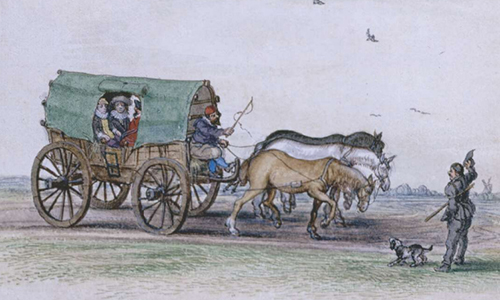Carrier’s Cart

Adriaen van de Venne Passengers in a Covered Waggon (1620-1626)
© The Trustees of the British Museum Item no 1978,0624.42.68
licensed under their Creative Commons Attribution-NonCommercial-ShareAlike 4.0 International (CC BY-NC-SA 4.0).
This image is online at the British Museum’s Collecction website.
Adriaen van de Venne (1589-1662) moved from Middelburg to the Hague in 1625 where he became a member of the St Luke’s (Painters) Guild. He specialised in genre painting of Dutch scenes, and illustrations for emblem books. His most famous work is probably the Rijksmuseum’s Fishing for Souls (1614), in which the two rival religious parties, Catholic and Protestant, are seen on the crowded banks of a river in which several boats are fishing for converts floundering in the water. The spectators are portraits of the European leaders of the religious parties at the time, including the Archdukes Albert and Isabella, and on the other side, the Princes of Orange and King James I and VI of Britain.
This covered waggon appears in several of his paintings. It is clearly Dutch — you can see the windmill in the background, and the terrain is helpfully flat. In England travel by wheeled transport was possible in the South and on the East side of the country, but more difficult on the narrower and more mountainous roads of the North West. Those who did not have their own coaches and could not afford a stage coach might be able to hire a lift on a carrier’s cart.
Close window to return.